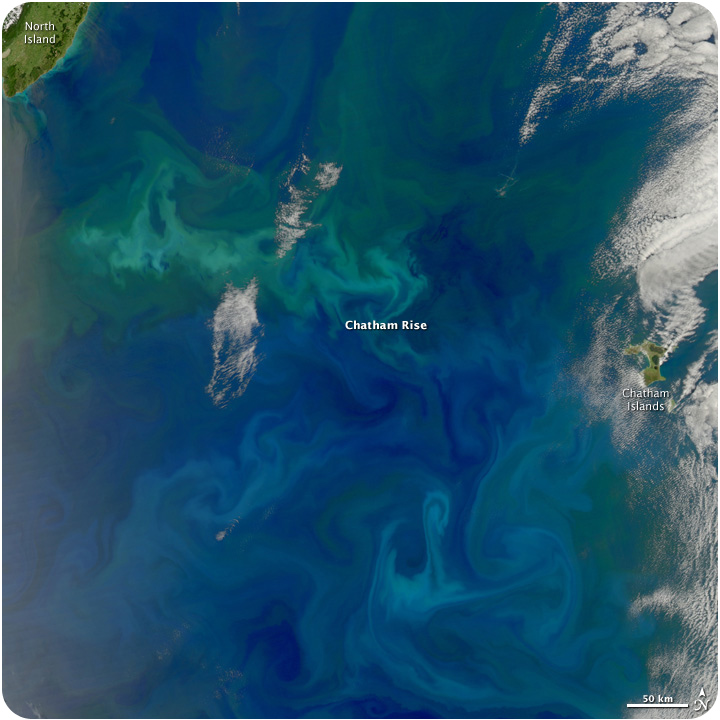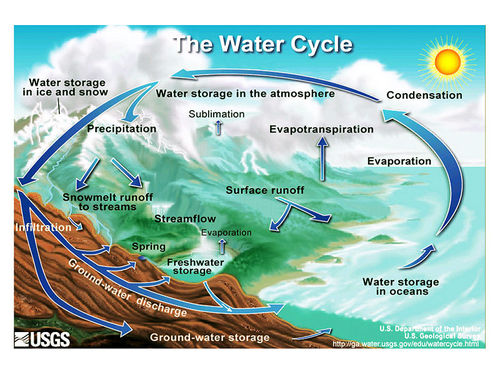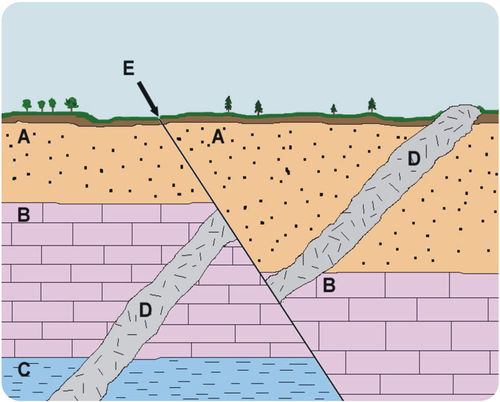Vocabulary
aphotic zone
biomass
intertidal zone
neritic zone
oceanic zone
photic zone
salinity
water column
Introduction
As terrestrial creatures, humans think of the importance of the planet’s land surfaces. But Earth is mostly a water planet. From space, the dominance of water is obvious (Figure below). Most of Earth’s water is in the oceans.
[Figure 1]
About 71% of the Earth’s surface is covered with water, mostly by the oceans.
Because all of Earth’s oceans are somehow connected, should this chapter be titled “Earth’s Ocean” or “Earth’s Oceans?” Try to decide by the end of the chapter.
An animation will help you see Earth's one, three, four, or five oceans: http://en.wikipedia.org/wiki/File:World_ocean_map.gif.
Significance of the Oceans
Earth would not be the same planet without its oceans.
Moderates Climate
The oceans, along with the atmosphere, keep temperatures fairly constant worldwide. While some places on Earth get as cold as -70oC and others as hot as 55oC, the range is only 125oC. On Mercury temperatures go from -180oC to 430oC, a range of 610oC.
The oceans, along with the atmosphere, distribute heat around the planet. The oceans absorb heat near the equator and then move that solar energy to more polar regions. The oceans also moderate climate within a region. At the same latitude, the temperature range is smaller in lands nearer the oceans than away from the oceans. Summer temperatures are not as hot, and winter temperatures are not as cold, because water takes a long time to heat up or cool down.
Water Cycle
The oceans are an essential part of Earth’s water cycle. Since they cover so much of the planet, most evaporation comes from the ocean and most precipitation falls on the oceans.
Biologically Rich
The oceans are home to an enormous amount of life. That is, they have tremendous biodiversity (Figure below). Tiny ocean plants create the base of a food web that supports all sorts of life forms. Marine life makes up the majority of all biomass on Earth. (Biomass is the total mass of living organisms in a given area.) These organisms supply us with food and even the oxygen created by marine plants.
[Figure 2]
A swimming polar bear is a tiny part of the immense biodiversity of the oceans.
Continental Margin
Recall from the Plate Tectonics chapter that the ocean floor is not flat: mid-ocean ridges, deep sea trenches, and other features all rise sharply above or plunge deeply below the abyssal plains. In fact, Earth’s tallest mountain is Mauna Kea volcano, which rises 10,203 m (33,476 ft.)meters) from the Pacific Ocean floor to become one of the volcanic mountains of Hawaii. The deepest canyon is also on the ocean floor, the Challenger Deep in the Marianas Trench, 10,916 m (35,814 ft).
The continental margin is the transition from the land to the deep sea or, geologically speaking, from continental crust to oceanic crust. More than one-quarter of the ocean basin is continental margin. (Figure below).
[Figure 3]
The continental margin is divided into the continental shelf, continental slope, and continental rise, based on the steepness of the slope.
Composition of Ocean Water
Remember from the Mineral's chapter that H2O is a polar molecule so it can dissolve many substances (Figurebelow). Salts, sugars, acids, bases, and organic molecules can all dissolve in water.
[Figure 4]
Ocean water is composed of many substances, many of them salts such as sodium, magnesium, and calcium chloride.
Where does the salt in seawater come from? As water moves through rock and soil on land it picks up ions. This is the flip side of weathering. Salts comprise about 3.5% of the mass of ocean water, but the salt content or salinity is different in different locations.
What would the salinity be like in an estuary? Where seawater mixes with fresh water, salinity is lower than average.
What would the salinity be like where there is lots of evaporation? Where there is lots of evaporation but little circulation of water, salinity can be much higher. The Dead Sea has 30% salinity—nearly nine times the average salinity of ocean water (Figure below). Why do you think this water body is called the Dead Sea?
[Figure 5]
The Dead Sea has such high salinity that people can easily float in it.
Interactive ocean maps can show salinity, temperature, nutrients, and other characteristics: http://earthguide.ucsd.edu/earthguide/diagrams/levitus/index.html.
With so many dissolved substances mixed in seawater, what is the density (mass per volume) of seawater relative to fresh water?
Water density increases as:
salinity increases
temperature decreases
pressure increases
Differences in water density are responsible for deep ocean currents, as will be discussed in the Ocean Movements lesson.
The Water Column
In 1960, two men in a specially designed submarine called the Trieste descended into a submarine trench called the Challenger Deep (10,910 meters) (Figurebelow).
[Figure 6]
The Trieste made a record dive to the Challenger Deep in 1960.
The average depth of the ocean is 3,790 m, a lot more shallow than the deep trenches but still an incredible depth for sea creatures to live in. What makes it so hard to live at the bottom of the ocean? The three major factors that make the deep ocean hard to inhabit are the absence of light, low temperature, and extremely high pressure.
Vertical Divisions
To better understand regions of the ocean, scientists define the water column by depth. They divide the entire ocean into two zones vertically, based on light level. Large lakes are divided into similar regions.
Sunlight only penetrates the sea surface to a depth of about 200 m, creating the photic zone (photic means light). Organisms that photosynthesize depend on sunlight for food and so are restricted to the photic zone. Since tiny photosynthetic organisms, known as phytoplankton, supply nearly all of the energy and nutrients to the rest of the marine food web, most other marine organisms live in or at least visit the photic zone.
In the aphotic zone there is not enough light for photosynthesis. The aphotic zone makes up the majority of the ocean, but has a relatively small amount of its life, both in diversity of type and in numbers. The aphotic zone is subdivided based on depth (Figure below).
[Figure 7]
Oceanographers divide the ocean into zones both vertically and horizontally.
Horizontal Divisions
The seabed is divided into the zones described above, but ocean itself is also divided horizontally by distance from the shore.
Nearest to the shore lies the intertidal(littoral) zone, the region between the high and low tidal marks. This hallmark of the intertidal is change: water is in constant motions in waves, tides, and currents. The land is sometimes under water and sometimes is exposed.
The neritic zone is from low tide mark and slopes gradually downward to the edge of the seaward side of the continental shelf. Some sunlight penetrates to the seabed here.
The oceanic zone is the entire rest of the ocean from the bottom edge of the neritic zone, where sunlight does not reach the bottom. The sea bed and water column are subdivided further, as seen in the above).
Lesson Summary
The oceans help to moderate Earth's temperatures.
The main elements in seawater are chlorine, sodium, magnesium, sulfate, and calcium.
The average salinity of the oceans is about 3.5%.
In seawater, if evaporation is high, salinity is high. If fresh water mixes in, salinity is low.
In the photic zone there is enough available light for photosynthesis.
The vast majority of the ocean lies in the aphotic zone, where there is not enough light for photosynthesis.
The ocean floor averages about 3,790 m but ocean trenches are as deep as 10,910 m.
The neritic zones are nearshore areas, including the intertidal zone. The oceanic zones are offshore regions of the ocean.




















































